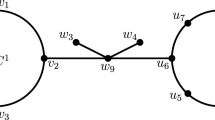Abstract
A permutation is called Grassmannian if it has at most one descent. The study of pattern avoidance in such permutations was initiated by Gil and Tomasko in 2021. We continue this work by studying Grassmannian permutations that avoid an increasing pattern. In particular, we count the Grassmannian permutations of size m avoiding the identity permutation of size k, thus solving a conjecture made by Weiner. We also refine our counts to special classes such as odd Grassmannian permutations and Grassmannian involutions. We prove most of our results by relating Grassmannian permutations to Dyck paths and binary words.


Similar content being viewed by others
Data availability
Data sharing not applicable to this article as no datasets were generated or analysed during the current study.
References
T. Alland and E. Richmond. Pattern avoidance and fiber bundle structures on Schubert varieties. J. Combin. Theory Ser. A, 154:533–550, 2018.
K. Anders and K. Archer. Rooted forests that avoid sets of permutations. European J. Combin., 77:1–16, 2019.
J.-C. Aval. Multivariate Fuss-Catalan numbers. Discrete Math., 308(20):4660–4669, 2008.
A. Bernini, L. Ferrari, R. Pinzani, and J. West. Pattern-avoiding Dyck paths. In 25th International Conference on Formal Power Series and Algebraic Combinatorics (FPSAC 2013), Discrete Math. Theor. Comput. Sci. Proc., AS, pages 683–694. Assoc. Discrete Math. Theor. Comput. Sci., Nancy, 2013.
S. C. Billey and J. E. Weaver. A pattern avoidance characterization for smoothness of positroid varieties. Sém. Lothar. Combin., 86B:Art. 57, 12, 2022.
A. Burstein. Number of balanced bracket sequences with given prefix and suffix. Mathematics Stack Exchange. https://math.stackexchange.com/q/4587979 (version: 2022-12-03).
D. Callan. Pattern avoidance in circular permutations. arXiv preprint math/0210014, 2002.
M. Dairyko, S. Tyner, L. Pudwell, and C. Wynn. Non-contiguous pattern avoidance in binary trees. Electron. J. Combin., 19(3):Paper 22, 21, 2012.
J. J. Fang, Z. Hamaker, and J. M. Troyka. On pattern avoidance in matchings and involutions. Electron. J. Combin., 29(1):Paper No. 1.39, 22, 2022.
C. Gaetz. Spherical Schubert varieties and pattern avoidance. Selecta Math. (N.S.), 28(2):Paper No. 44, 9, 2022.
S. Garg and A. Peng. Classical and consecutive pattern avoidance in rooted forests. J. Combin. Theory Ser. A, 194:Paper No. 105699, 52, 2023.
J. B. Gil and J. A. Tomasko. Restricted Grassmannian permutations. Enumer. Combin. Appl., 2(S4PP6), 2022.
J. B. Gil and J. A. Tomasko. Pattern-avoiding even and odd Grassmannian permutations. Australas. J. Combin., 86:187–205, 2023.
A. M. Goyt. Avoidance of partitions of a three-element set. Adv. in Appl. Math., 41(1):95–114, 2008.
S. Heubach and T. Mansour. Combinatorics of compositions and words. Discrete Mathematics and its Applications (Boca Raton). CRC Press, Boca Raton, FL, 2010.
P. Hilton and J. Pedersen. Catalan numbers, their generalization, and their uses. Math. Intelligencer, 13(2):64–75, 1991.
M. Klazar. On \(abab\)-free and \(abba\)-free set partitions. European J. Combin., 17(1):53–68, 1996.
D. E. Knuth. The art of computer programming. Volume 3. Addison-Wesley Series in Computer Science and Information Processing. Addison-Wesley Publishing Co., Reading, Mass.-London-Don Mills, 1973. Sorting and searching.
W. Lang. On polynomials related to powers of the generating function of Catalan’s numbers. Fibonacci Quart., 38(5):408–419, 2000.
K. Menon and A. Singh. Pattern avoidance of \([4,k]\)-pairs in circular permutations. Adv. in Appl. Math., 138:Paper No. 102346, 51, 2022.
E. S. Rowland. Pattern avoidance in binary trees. J. Combin. Theory Ser. A, 117(6):741–758, 2010.
R. Simion and F. W. Schmidt. Restricted permutations. European J. Combin., 6(4):383–406, 1985.
N. J. A. Sloane. The On-Line Encyclopedia of Integer Sequences. http://oeis.org.
R. P. Stanley. Catalan numbers. Cambridge University Press, 2015.
The Sage Developers. SageMath, the Sage Mathematics Software System (Version 9.5.0), 2022. https://www.sagemath.org.
A. Vella. Pattern avoidance in permutations: Linear and cyclic orders. Electron. J. Comb., 9(2):research paper r18, 43, 2003.
A. Woo and A. Yong. When is a Schubert variety Gorenstein? Adv. Math., 207(1):205–220, 2006.
Acknowledgements
We would like to thank Michael Weiner for his comments on an earlier version of this paper. We would also like to thank the referees for their careful reading and helpful suggestions. The computer algebra system SageMath [25] provided valuable assistance in studying examples. This work was done during the first author’s visit to the Indian Institute of Technology Bhilai, funded by SERB, India, via the project AV/VRI/2022/0140. Krishna Menon is partially supported by a grant from the Infosys Foundation, and Anurag Singh is partially supported by the Research Initiation Grant from the Indian Institute of Technology Bhilai (No. 2009301).
Author information
Authors and Affiliations
Corresponding author
Ethics declarations
Conflict of interest
On behalf of all authors, the corresponding author states that there is no conflict of interest.
Additional information
Communicated by Bridget Tenner.
Publisher's Note
Springer Nature remains neutral with regard to jurisdictional claims in published maps and institutional affiliations.
Rights and permissions
Springer Nature or its licensor (e.g. a society or other partner) holds exclusive rights to this article under a publishing agreement with the author(s) or other rightsholder(s); author self-archiving of the accepted manuscript version of this article is solely governed by the terms of such publishing agreement and applicable law.
About this article
Cite this article
Menon, K., Singh, A. Dyck Paths, Binary Words, and Grassmannian Permutations Avoiding an Increasing Pattern. Ann. Comb. (2023). https://doi.org/10.1007/s00026-023-00667-x
Received:
Accepted:
Published:
DOI: https://doi.org/10.1007/s00026-023-00667-x




